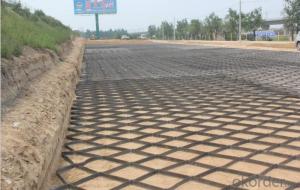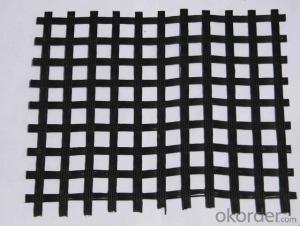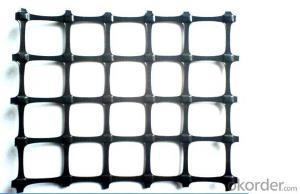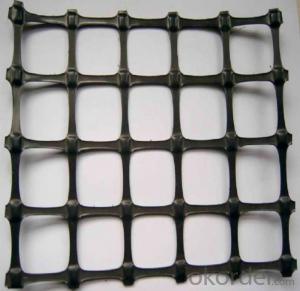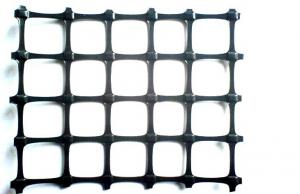Manufactured PP Uniaxial Geogrid with High Strength
- Loading Port:
- China main port
- Payment Terms:
- TT OR LC
- Min Order Qty:
- 5000 m²
- Supply Capability:
- 1000000 m²/month
OKorder Service Pledge
OKorder Financial Service
You Might Also Like
Introduction of PP/HDPE Uniaxial Geogrid:
Uniaxial geogrid, made of high molecular polymer, is extruded into sheet and then punched into regular mesh pattern, and finally stretched in the longitudinal direction.
Features of PP/HDPE Uniaxial Geogrid:
With high tensile strength and tensile modulus
Application of PP/HDPE Uniaxial Geogrid:
Mainly applied in highway, railway, slope protecting projects, retaining wall, dam etc.
1)strengthen land loading capacity and extend its service life.
2) convenient to construct ; reducing area , project cost and maintenance cost.

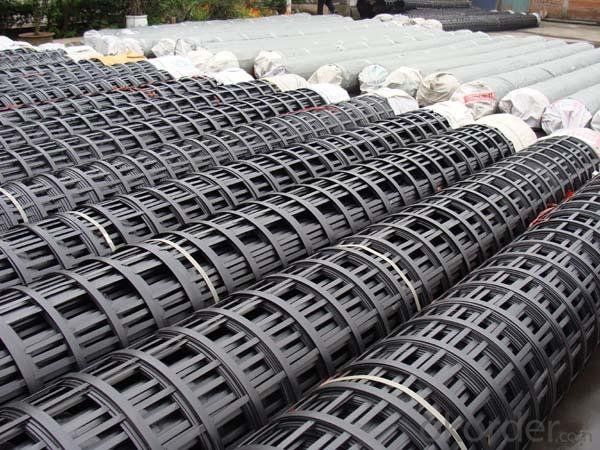
Performance of Fiberglass Geogrid:
--- High strength, high modulus and low temperatures resistance.
Applications of Fiberglass Geogrid:
--- Reinforcement for road pavement
--- Reinforcement for railway basement
--- Reinforcement for Tunnel
--- Reinforcement for Slope
--- Reinforcement for embankment.
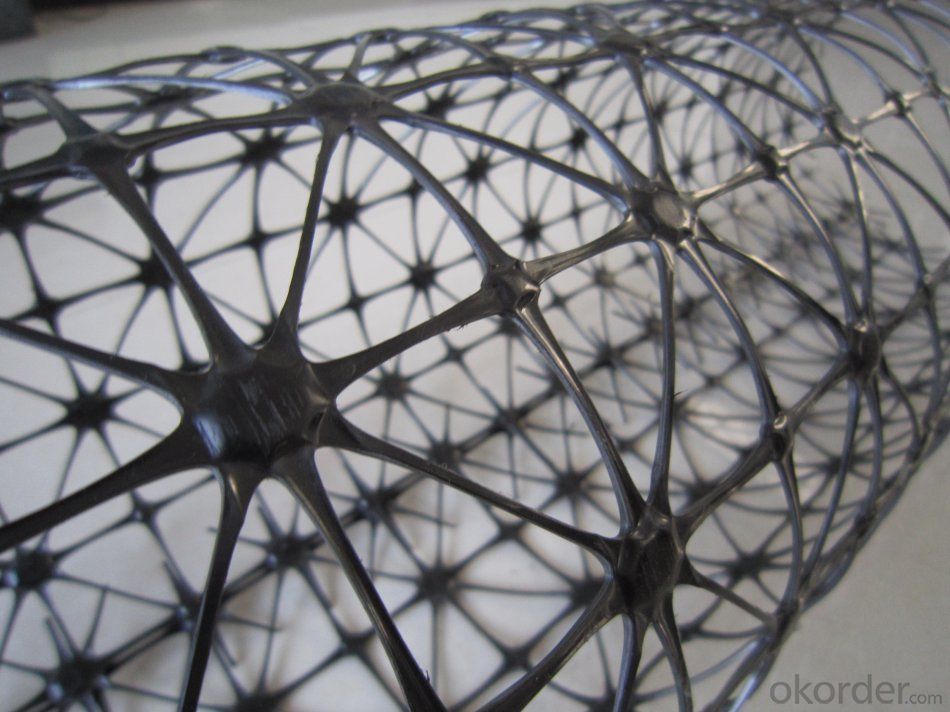
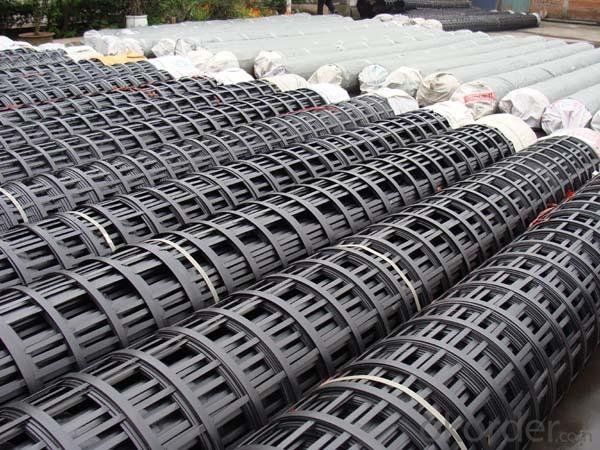
Features of PP Biaxial Geogrid:
1. With high tensile strength in longitudinal and transversedirections
2.This structure can provide an chain system of more effective force bearing and spreading for the soil.
Application of PP Biaxial Geogrid:
Mainly applied in highway, railway, slope protecting projects etc.
1)strengthen land loading capacity and extend its service life.
2) convenient to construct ; reducing project cost and maintenance cost.
FAQ:
Q1: What is your minimum order quantity?
A:The minimum order quantity is 5000 ,but it is negotiable.
Q2:What is your payment terms?
A: T/T,Western Union,Paypal,L/C...
Q3:What is your delivery time?
A:Production time usually costs 2-20 days.
Waiting to cooperate with you!
- Q:How do geogrids improve the performance of geocell-reinforced slopes for erosion control?
- Geogrids improve the performance of geocell-reinforced slopes for erosion control by providing additional strength and stability. They help distribute the load evenly across the slope, preventing soil movement and reducing erosion. Additionally, geogrids increase the frictional resistance between soil layers, enhancing the overall slope stability and preventing soil slippage.
- Q:How do geogrids improve the load-bearing capacity of foundations?
- Geogrids improve the load-bearing capacity of foundations by providing reinforcement and stability to the soil. These geosynthetic materials are placed within the soil layers and their interlocking geometry creates a more rigid and compact structure. This helps distribute the load evenly across a wider area, reducing the risk of settlement and increasing the overall strength of the foundation.
- Q:How do geogrids improve the stability of mechanically stabilized earth walls?
- Geogrids improve the stability of mechanically stabilized earth walls by providing reinforcement and increasing the tensile strength of the soil. They act as a stabilizing element, distributing the forces and preventing the soil from shifting or sliding. Geogrids also improve the overall bearing capacity of the wall, allowing for the construction of taller and more stable structures.
- Q:Are geogrids effective in stabilizing dredged material containment areas?
- Yes, geogrids are effective in stabilizing dredged material containment areas. They provide reinforcement and stability to the soil, preventing erosion and maintaining the integrity of the containment area. Geogrids are specifically designed to distribute and manage loads, improving the overall performance and long-term stability of dredged material containment areas.
- Q:Can geogrids be used in bridge construction?
- Yes, geogrids can be used in bridge construction. Geogrids are often used as reinforcement materials in bridge foundations, abutments, and retaining walls to improve the stability and load-bearing capacity of the structure. They are effective in preventing soil erosion, reducing settlement, and distributing loads, making them a valuable component in bridge construction projects.
- Q:What are the properties and characteristics of geogrids?
- Geogrids are synthetic materials with high tensile strength, used in civil engineering and construction projects. They are typically made from polymers such as polyester or polypropylene and have a grid-like structure. The properties and characteristics of geogrids include: 1. Tensile Strength: Geogrids possess high tensile strength, allowing them to withstand heavy loads and distribute stress efficiently. This property makes them suitable for applications such as soil stabilization and reinforcement. 2. Aperture Size: Geogrids have a grid-like structure with different aperture sizes, which can vary based on the intended use. The aperture size determines the amount of soil interlock and confinement provided by the geogrid. 3. Flexibility: Geogrids exhibit flexibility, enabling them to conform to the shape of the terrain or structure they are applied to. This flexibility allows for easier installation and adaptability to different project requirements. 4. Durability: Geogrids are designed to be highly durable and resistant to environmental conditions such as ultraviolet (UV) radiation, chemical exposure, and biological degradation. This durability ensures the long-term performance and lifespan of geogrids in various applications. 5. Installation Ease: Geogrids are generally lightweight and easy to handle, facilitating their installation. They can be rolled out or placed directly onto the ground, minimizing the time and effort required for construction. 6. Soil Interaction: Geogrids enhance the interaction between soil particles, increasing their shear resistance and improving overall stability. This property is especially beneficial in applications like retaining walls, slopes, and roadways. 7. Drainage Capability: Some geogrids have a porous structure that allows for water drainage, preventing the buildup of hydrostatic pressure and reducing the risk of soil erosion. Overall, geogrids offer a range of beneficial properties and characteristics that make them versatile and effective in various civil engineering and construction applications.
- Q:Introduction of steel plastic grille
- By a single band,
- Q:Can geogrids be used in stabilization of riverbanks?
- Yes, geogrids can be used in the stabilization of riverbanks. Geogrids are often used to reinforce and stabilize soil in various applications, including erosion control along riverbanks. Their high tensile strength and ability to distribute loads make them effective in preventing soil erosion and maintaining the stability of riverbanks.
- Q:What are the factors that affect the design and selection of geogrids for geosynthetic reinforcement of reinforced soil slopes?
- There are several factors that influence the design and selection of geogrids for geosynthetic reinforcement of reinforced soil slopes. These factors include the slope height, slope angle, soil properties, anticipated loads, and environmental conditions. The geogrid must have sufficient strength and stiffness to resist the applied loads and prevent slope failure. It should also be compatible with the soil, allowing for proper interaction and soil-geogrid interface friction. Additionally, the durability and longevity of the geogrid in the given environmental conditions, such as temperature variations and chemical exposure, should be considered. Overall, the design and selection of geogrids for geosynthetic reinforcement of reinforced soil slopes require a comprehensive assessment of these factors to ensure the stability and long-term performance of the slope.
- Q:Can geogrids be used for reinforcement in asphalt overlays?
- Yes, geogrids can be used for reinforcement in asphalt overlays. Geogrids are commonly used in pavement applications to enhance the structural integrity of asphalt overlays by reducing cracking and improving overall pavement performance.
1. Manufacturer Overview |
|
|---|---|
| Location | |
| Year Established | |
| Annual Output Value | |
| Main Markets | |
| Company Certifications | |
2. Manufacturer Certificates |
|
|---|---|
| a) Certification Name | |
| Range | |
| Reference | |
| Validity Period | |
3. Manufacturer Capability |
|
|---|---|
| a)Trade Capacity | |
| Nearest Port | |
| Export Percentage | |
| No.of Employees in Trade Department | |
| Language Spoken: | |
| b)Factory Information | |
| Factory Size: | |
| No. of Production Lines | |
| Contract Manufacturing | |
| Product Price Range | |
Send your message to us
Manufactured PP Uniaxial Geogrid with High Strength
- Loading Port:
- China main port
- Payment Terms:
- TT OR LC
- Min Order Qty:
- 5000 m²
- Supply Capability:
- 1000000 m²/month
OKorder Service Pledge
OKorder Financial Service
Similar products
New products
Hot products
Hot Searches
Related keywords
